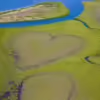Vanuatu Travel Guide
Welcome to the taste2travel Vanuatu Travel Guide!
Date Visited: September 2018
Introduction
Home to some of the friendliest people on the planet, remote and rugged volcanic islands, an ancient culture, world-class diving, active volcanoes, pristine tropical beaches, rainforests, waterfalls, fine dining, quaffable organic coffee, melt-in-your-mouth chocolate and so much more, the Republic of Vanuatu offers a plethora of travel experiences for those willing to take the time to venture off the beaten track.
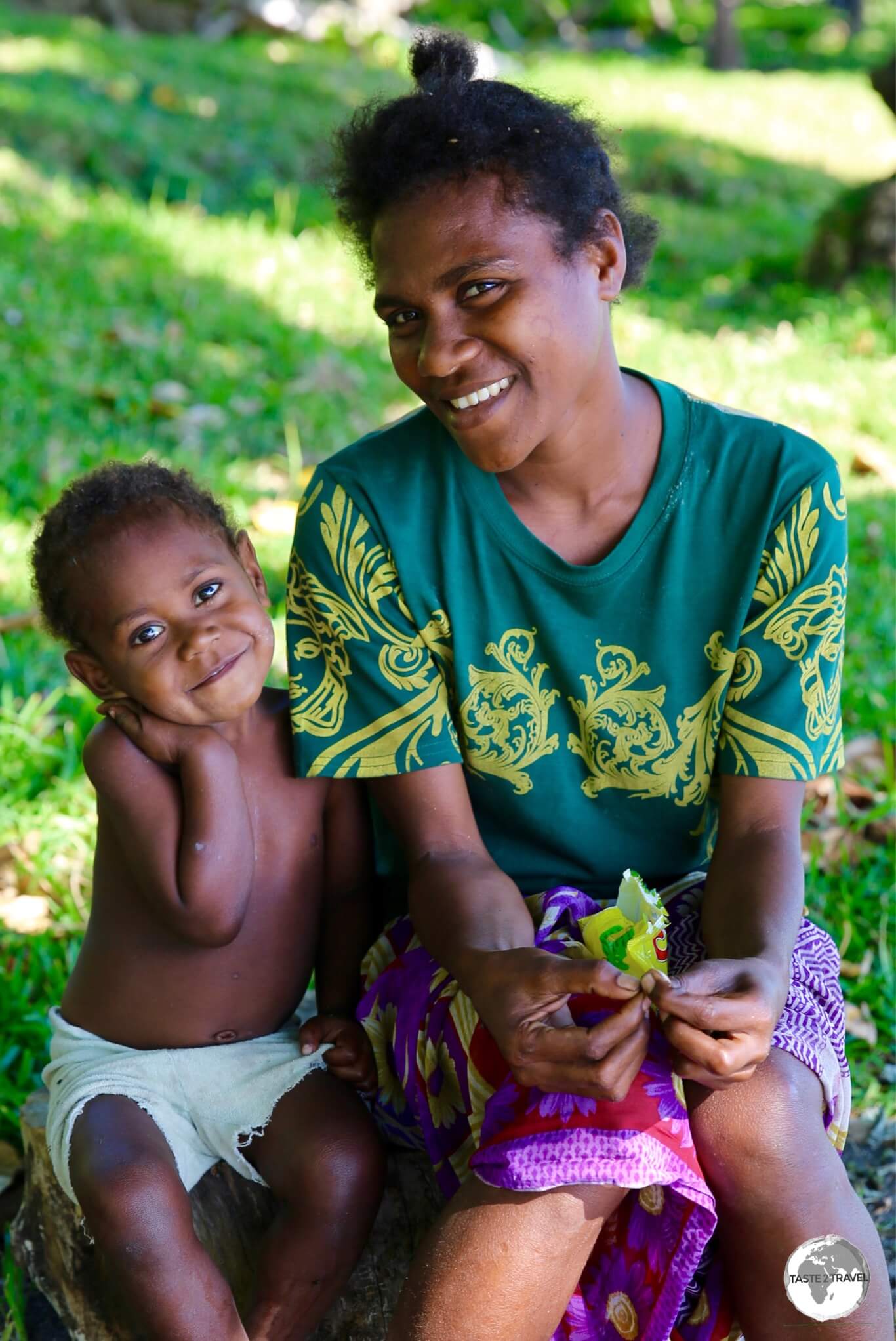
Mother and son relaxing on the beach on Tanna.
An archipelago of 83 islands (65 of which are inhabited and 13 of which are considered ‘main’ islands), most visitors first arrive on the island of Éfaté which is home to the capital and largest city, Port Vila, and the main international airport, Bauerfield International Airport. According to the Vanuatu National Statistics Office, 13,184 (53%) of visitors in 2017 arrived by air, while 11,662 (47%) arrived via cruise ship, spending just one day in Port Vila.

A smiley young girl, distracted in a church service on Tanna island.
During my time in the country, I explored the islands of Éfaté, Tanna and Espiritu Santo, the highlights of which were standing on the edge of the very active Mount Yasur volcano on Tanna, diving on the world’s largest shipwreck, the SS Coolidge, on Espiritu Santo and enjoying fine dining in Port Vila.

Happy, free-range cows on Éfaté. The beef from Vanuatu is some of the best I’ve every tasted!
As someone who enjoys a good steak, I’m now a fully fledged fan of Vanuatu beef – some of the best beef I’ve ever tasted – incredibly tasty, tender, free-range and always organic. Most cows on Vanuatu graze in large, open coconut plantations where they keep the grass low between the rows of palms.

No such thing as a ‘bad hair day’ on Vanuatu.
If you’re looking for a tropical paradise which offers a range of incredible travel experiences, Vanuatu and its friendly inhabitants await!
Location
Port Vila, Vanuatu
Located in the South Pacific, 975 km south-east of the Solomon Islands, 800 km west of Fiji and 1,750 km east of Australia, Vanuatu is a Y-shaped archipelago of 83 volcanic islands which extend north-south for 650 km. The largest island is the sparsely populated Espiritu Santo while the main hub is the island of Éfaté.
People

Children in Port Vila central market.
The 270,000 inhabitants of Vanuatu are called ni-Vanuatu (often abbreviated to ‘Ni-Van’) and are predominately (98.5%) Melanesian. Historians believe that, along with Australian Aborigines, the Melanesians emigrated from Africa into southern Asia between 50,000 and 100,000 years ago.

A map of the Melanesian region of the Pacific Ocean.
Source: Wikipedia
By using land bridges which existed due to low sea levels, they eventually migrated east to Australia and New Guinea, arriving there 40,000 years ago.

A young boy waiting on a boat in Port Vila harbour.
A further migration into the eastern islands of Melanesia (including Vanuatu) came much later, probably between 4000 B.C. and 3000 B.C. DNA tests have shown that the Melanesians are distinctly different to Polynesians and Micronesians, who it’s believed arrived in the Pacific from what is today Taiwan.
Blond Hair

A cool dude with a shock of blond hair in Port Vila.
Melanesians are one of a few groups of non-Caucasian people who have a gene which produces blond hair. It’s especially common among children and it’s not uncommon to see kids in Vanuatu sporting crazy, frizzy, blond hair.

The ni-Van are wonderfully friendly and the children very curious.
Flag

The flag of Vanuatu features a pig’s tusk which is deemed sacred and was traditionally used as a form of currency.
The flag of Vanuatu was adopted at the time of the nations independence in 1980. As for the design, the green represents the richness of the islands, the red symbolises blood which unites humanity as humans, and the black the ni-Vanuatu people.
The then Prime Minister of Vanuatu, Father Walter Lini, requested the inclusion of yellow and black fimbriations to make the black stand out. The yellow Y-shape represents the shape of Vanuatu islands on the map.
The emblem in the black is a boar’s tusk — the symbol of customs and tradition but also prosperity. Its worn as a pendant on the islands – along with two leaves of the local namele tree. These leaves are supposed to be a token of peace.
Currency & Costs

The front of the new 5,000 Vatu polymer banknote.
Currency
The currency of Vanuatu is the colourful Vatu (VT or VUV) – with notes in denominations of 200 VT, 500 VT, 1000 VT, 2000 VT, 5000 VT and 10,000 VT.
Currency is issued by the Reserve Bank of Vanuatu with banknotes printed on polymer by Thomas de La Rue of the UK and feature cultural references.
Exchange rates are:

The back of the new 5,000 Vatu polymer banknote.
Costs
Despite being a developing country, Vanuatu is not a cheap destination with travel costs (hotels, airfares, restaurant meals etc) often costing more than in neighbouring Australia.
If you wish to travel between islands, inter-island flights are the only convenient option and all flights are operated by the monopoly carrier, Air Vanuatu, whose airfares fully reflect the lack of competition. Flights are sold in segments at the same price (no discount for return bookings) with a one way flight from Éfaté to Tanna (40 mins) costing US$115 with the return ticket costing double that amount. Ouch!

A Tusker Beer advertisement in Port Vila.
Some sample costs (as at October 2018):
- Cappuccino/ Café latte: 500VT
- Bottle of local Tusker beer: 500VT
- Can of Coca Cola: 350VT
- Meal in an inexpensive restaurant: 1,200VT
- Pad Thai noodle in Port Vila: 1,500 – 2,000VT
- Steak meal in a fine-dining restaurant: 4,500VT
- Entrance to Mele Waterfalls: 2,000VT (USD$18)

At USD$18, the Mele waterfalls are wonderfully refreshing but not especially cheap!
Philately
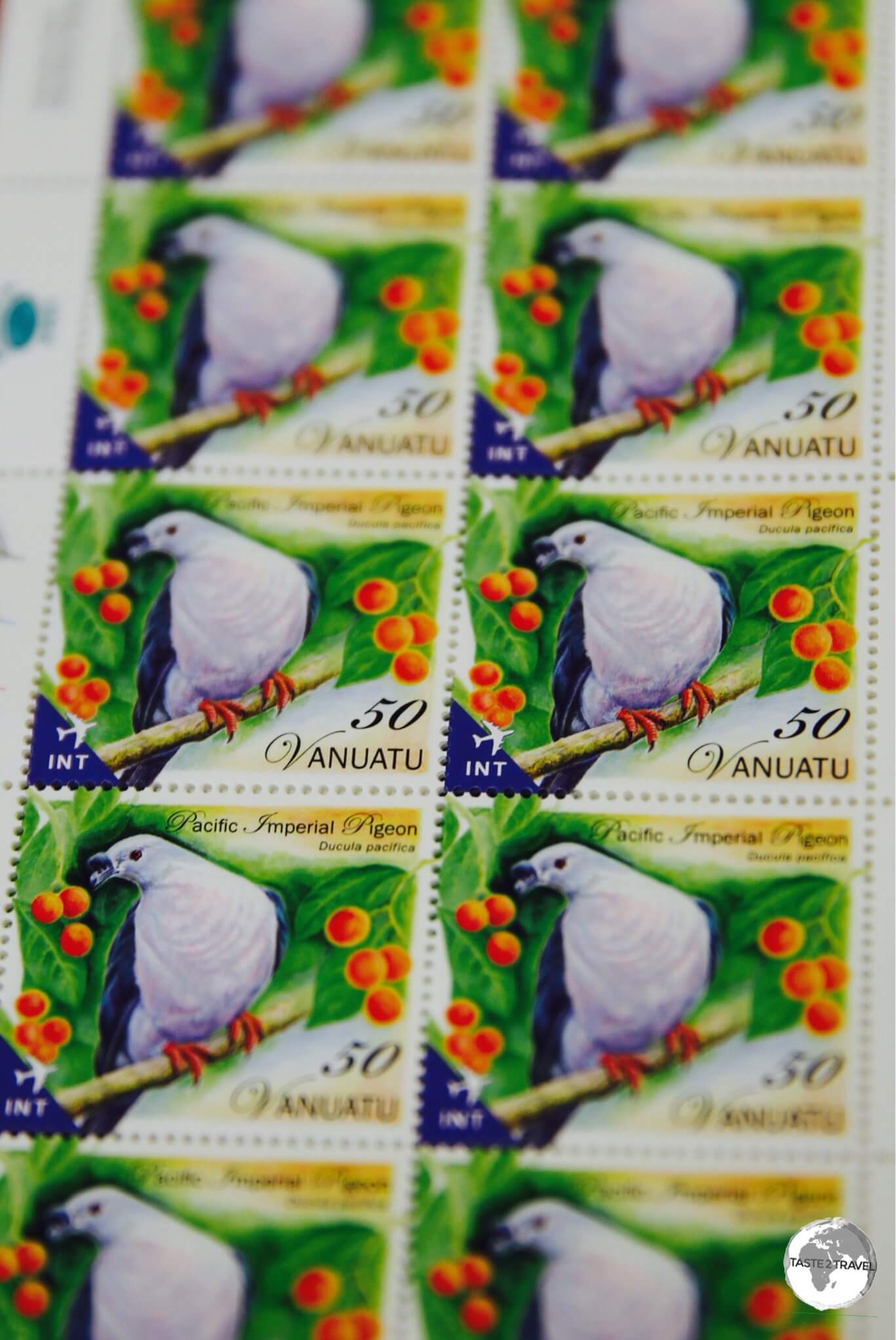
The stamps of Vanuatu feature local fauna and flora.
The stamps of Vanuatu are printed in Dunedin, New Zealand and are popular with international collectors. You can view and purchase stamps online from the Vanuatu Post website or from the General Post Office (GPO) in Port Vila.

Vanuatu stamps are popular among philatelists around the world.
Post-Boxes
The folks at Vanuatu Post clearly have a sense of humour and have no problem thinking ‘outside the (post) box‘. As I travelled around the country, I noticed post boxes in some interesting and truly bizarre locations.
One which has made international headlines is to be found at Hideaway Island Marine Sanctuary, home to the world’s only underwater post office, which is located at a depth of 3 metres.

A post box, which is cleared twice daily, on the slopes of Mount Yasur Volcano on Tanna.
Elsewhere, you’ll find a post box living dangerously on the edge of the crater at Mount Yasur volcano on the island of Tanna and one very lonely post box located on a remote beach on the back of Lelepa island (not sure of the clearing times of this one!).

Can you spot the hidden post box? A lonely post box installed on an isolated beach on Lelepa Island.
Sightseeing

Sunset over Port Vila harbour.
Éfaté Island
Most visitors to Vanuatu first arrive on the main island of Éfaté which is home to the charming, waterfront capital of Port Vila and the main international airport.

A friendly boy near Takara Hot Springs on Efate.
Outside of the capital, Éfaté offers pristine nature, plunging waterfalls, a blue lagoon swimming hole, snorkeling, diving, abundant marine life, boiling hot thermal springs, WWII relics and so much more.

Local handicrafts, such as these on Tanna island, are popular and affordable souvenirs.
Nearby, offshore islands make for interesting day-trips, including Lelepa, which was used as one of the film locations for the US reality television show Survivor: Vanuatu.
Within sight of Lelepa, Hat island, is famous as the burial site of the great Vanuatu Chief, Roi Mata, who had members of his court and family (including 40 wives) buried alive at his side to accompany him on his final voyage. Today the islands are part of Vanuatu’s one and only UNESCO World Heritage Site.

A colourful restaurant in downtown Port Vila.
A 130 km, paved ring road around Éfaté makes exploring the island by rental car ideal. If you plan to visit different sights on Éfaté, you should ensure you bring sufficient cash.
There are no ATMs outside of Port Vila and credit card facilities are non-existent. Entrance fees can be surprisingly expensive (e.g. 2000VT to enter Mele Waterfalls, 1500VT to enter Raru Rentapau River waterfall,1500VT to bathe in the Takara Hot Springs and have a mud-bath) so a day spent visiting different sights can quickly burn through your cash.
Port Vila
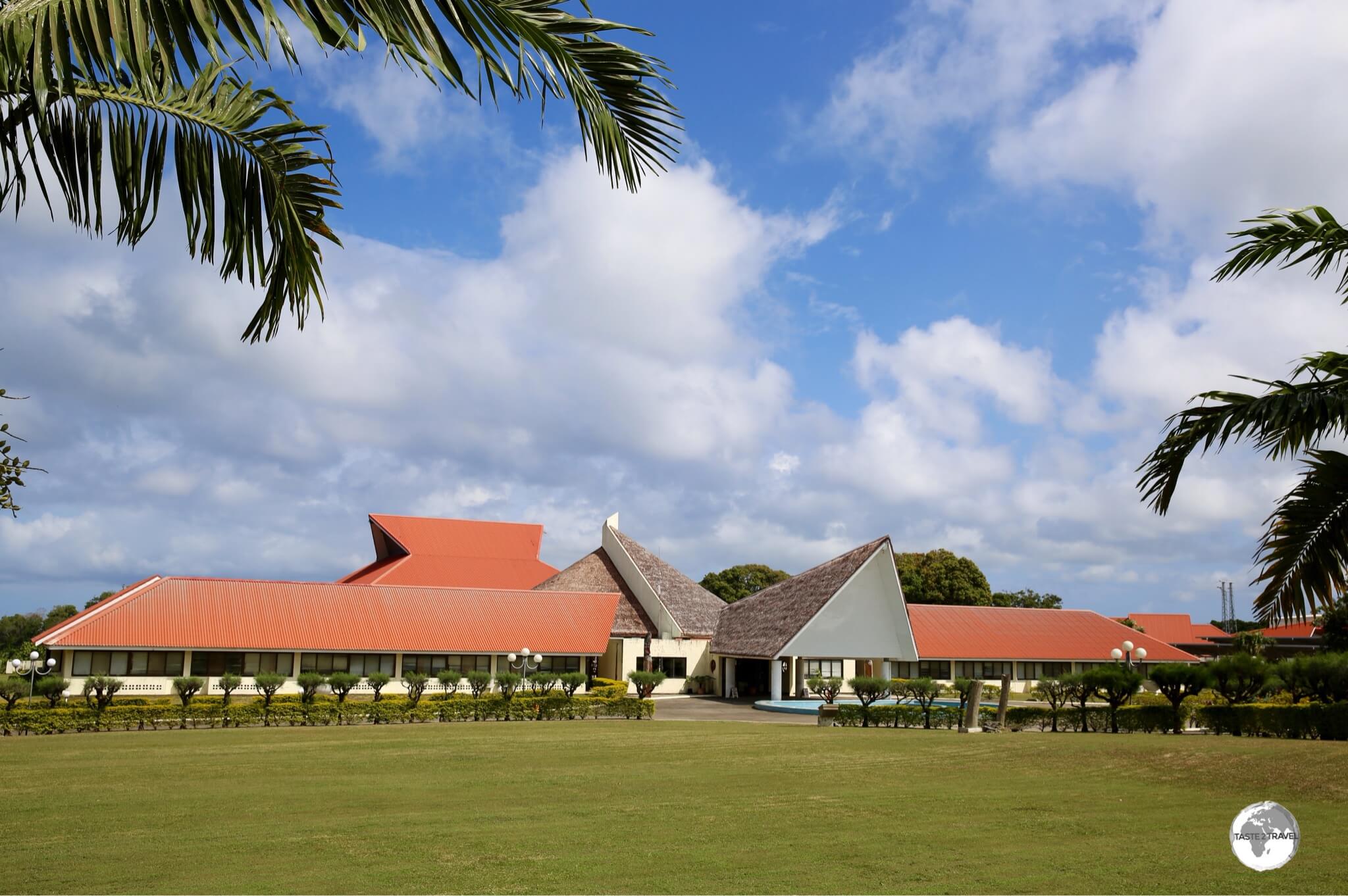
Vanuatu Parliament House in Port Vila.
The capital and largest town of Vanuatu, charming Port Vila (pop: 44,000) is located on a picturesque, natural harbour which now (thanks to a recently completed, New Zealand-funded, aid project), is fully accessible via a wide concrete pedestrian promenade that includes many stylish features such as stainless-steel railings, wooden and concrete bench seats, sculptures and lots of grassy areas.

There are plenty of French influences in Vanuatu including the love of ‘Boules’, being played here in Port Vila.
A handicraft market, various restaurants, a ‘Boules‘ ground and the ever-popular Nambawan Cafe (which screens free movies on their large outdoor screen each Wednesday, Saturday and Sunday evening) makes the harbour front the perfect place to relax anytime during the day but especially in the evening when the sun sets majestically into the sea.

Flights with Vanuatu Helicopter depart from their floating helipad in the harbour.
Next to the Nambawan cafe, is the office for Big Blue Scuba Diving (single dive: 7,900VT/ two-tank dive: 14,900VT) who organise daily dives to nearby wrecks and reefs. Next to Big Blue, is the office of Vanuatu Helicopter who offers flights from their offshore helipad.

A wonderful way to spend an evening on Port Vila harbour is on a sunset cruise with Captain George.
If you wish to observe the sunset from the harbour, you can join Captain George of Meridian Charters for one of his regular sunset cruises aboard his beautiful old sailing boat. Captain George can be found during the day at Le Cafe du Village and charges 5,500VT per person, which includes two complimentary drinks (including Champagne) and finger food.

A selection of some of the fine organic chocolate available from Gaston Chocolat in Port Vila.
One block inland, the busy main street of Port Vila, the Kumul highway, is lined with souvenir and duty-free shops, cafés, restaurants and at least two organic chocolate shops.
One of these shops is Gaston Chocolat, which produces beautiful hand-crafted chocolate bars made from locally grown cocoa. The other, much smaller shop belongs to the very popular Aelan Chocolate who have a much more interesting factory shop on the outskirts of town (see the ‘Around Éfaté‘ section below for more details).

The bustling Central market in Port Vila is open 24×7.
The main hub of activity in Port Vila is the colourful, busy and always open (yes – 24×7) Central Market, which is literally home to a small army of sellers who sleep on mats at their stalls.
The range and quality of produce is astounding and so plentiful that it’s stacked up in the aisles. There is no ‘organic‘ designation in Vanuatu as all produce is organically grown by small-scale farmers.

The National Museum of Vanuatu in Port Vila.
Port Vila has few sights to visit but one that shouldn’t be missed is the National Museum of Vanuatu (1,000VT), which is located on a hill opposite Parliament house.

A display at the National Museum of Vanuatu in Port Vila.
While the displays are dusty and tired, the real star of the museum is the amazing Edgar Hinge. Edgar, who is employed as a museum guide, is a keen ambassador and promoter of Vanuatu’s culture and history.
So much more than a guide, Edgar is a master storyteller and uses the ancient art of ‘Sandroing‘ (Sand-drawing) to tell stories of Vanuatu’s history and culture.

Edgar Hinge of the National Museum of Vanuatu, telling a story using the ancient art of Sand-drawing.
A sand-drawing is created using one finger which moves in a continuous, flowing movement over a grid to draw a graceful, often symmetrical composition of geometric patterns. The story relating to the drawing is told as the drawing is slowly revealed. After the sand-drawing, Edgar provides an entertaining demonstration of local instruments.
Video:
Edgar Hinge, of the National Museum of Vanuatu, uses sand-drawing to tell the story of Black-birding, which was the colonial practice of kidnapping Pacific Islanders and transporting them via ship to Australia to work as labourers on sugar plantations in Queensland.

The finished ‘Black-birding’ drawing by Edgar Hinge of the National Museum of Vanuatu.
I would describe Edgar as a national treasure. He has a special presence and energy and spending time with him was one of the highlights of my trip to Vanuatu.
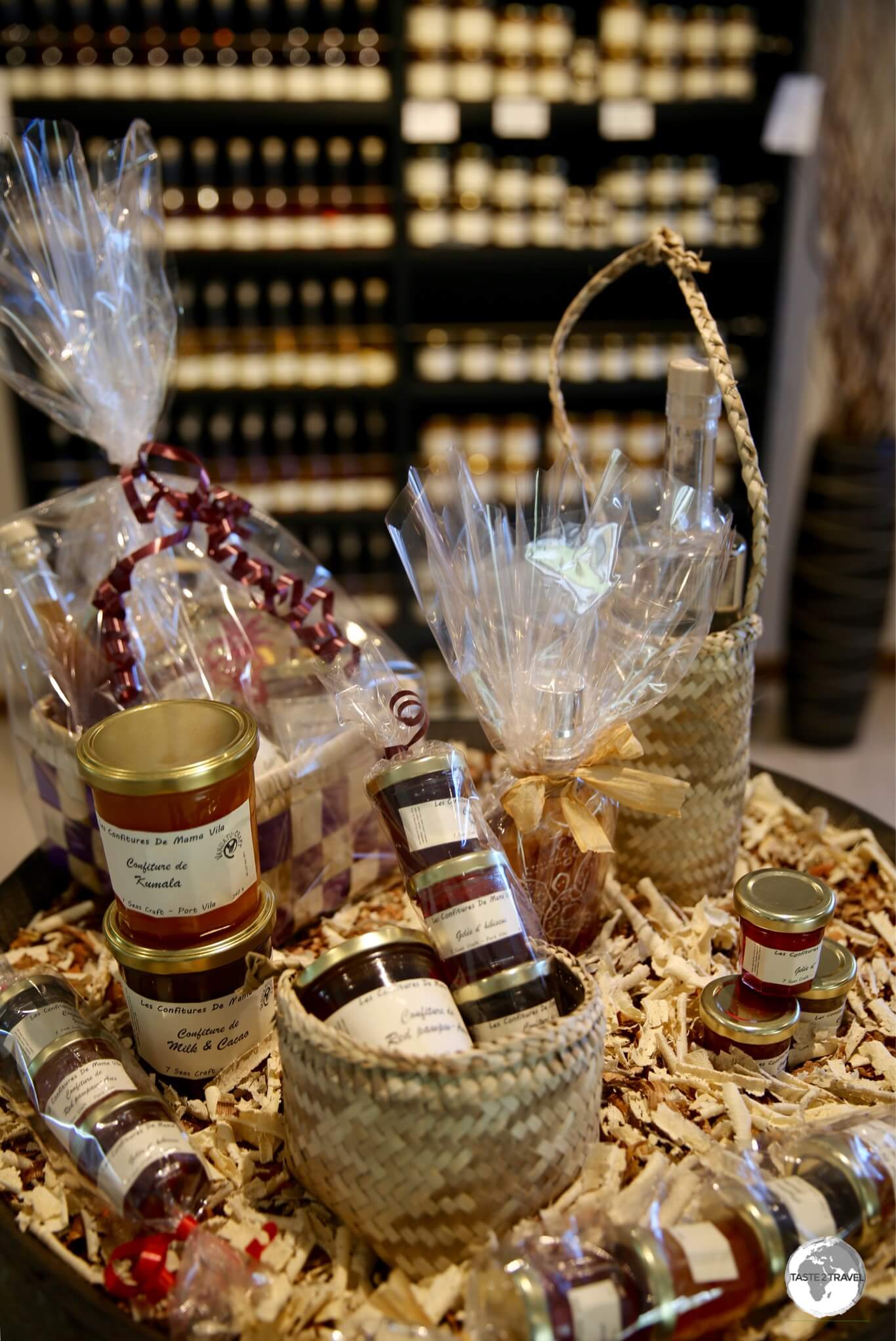
Some of the delicious products produced by Vanuatu Craft using local fruits.
Located on the outskirts of Port Vila, next to the Tusker brewery (which does not offer tours), Vanuatu Craft is an association selling liqueurs and jams which are produced from local fruits. My favourite is their Raspberry jam, which is made from the native Vanuatu Raspberry – Rubus rosifolius.

Native Vanuatu Raspberries on sale at the Central market.
Mele Village

Mele waterfalls are the ideal place for a refreshing dip.
Located a short drive from Port Vila, tiny Mele is home to a few worthwhile attractions, including the beautiful Mele waterfalls (2,000VT). The falls are a 20 minute hike from the entrance point but, once there, they provide the ultimate refreshing escape from the sun and midday heat.

Amazingly fresh coffee served with a hint of friendly attitude at the Tanna Roasting Company.
Located in the village of Mele (10 minutes from Port Vila) is the Tanna Coffee Roasting Factory. Green beans are shipped from Tanna to Port Vila, where they are roasted and packaged by hand at this factory.
Tours of the factory are free, while a onsite cafe will satisfy any post-tour caffeine cravings. Light meals and superb cakes (the Lemon Meringue tart is highly recommended) are also available.

A display at the Secret Garden provides information on first European Contact with Vanuatu.
Also in Mele is the eclectic and engaging Secret Garden. Set in lush grounds, the Secret Garden is full of informative displays which covers the full gamut of Vanuatu history, culture and traditions.
If you wish to learn about head-hunters, cannibals, wives being buried alive alongside their dead husbands, first European-contact and so much more, then the Secret Garden is the place.

Cannibalism is just one of the many subjects covered at the Secret Garden in Mele.
Around Éfaté Island
Travelling anti-clockwise from Port Vila, I covered most sights on the 130 km circuit in a full day, although two days would allow a more relaxed pace. There are few restaurants outside of Port Vila, but the restaurant at The Havannah resort was recommended and did not disappoint. Definitely worth the stop!

Products at the Aelan Chocolate factory near Port Vila.
First stop after leaving Port Vila was the Aelan Chocolate factory which sources its cocoa beans from small producers located on 4 different islands – Malo, Epi, Santo and Malekula. Due to their different environments, each island produces a bean whose taste is very distinct from the others.

The beautiful waterfall at Raru Rentapau River.
Located near the village of Teouma, Raru Rentapau River waterfall (1,500VT) offers the opportunity to swim in the crystal-clear waters of the river which cascade over waterfalls and flow through various rock-pools. Very refreshing!

Blue Lagoon is a place to unwind and swing like a monkey!
Located south of Eton village, on the main road, is the very popular Blue Lagoon (500VT) – a saltwater swimming hole with ropes, swings, canoes and picnic areas.

Blue Lagoon is a protected salt-water inlet.
A short drive north of Blue Lagoon, Eton beach (500VT) is a popular white-sand beach.

The thermal pools at Takara Hot Springs which are located on the north-east coast of Efate.
On the north coast of Éfaté, 46 km from Port Vila is the Takara Hot Springs, a low-key thermal pool complex with one mud pond which you can roll around in. Entrance is 1,500VT for bathers or 500VT for onlookers.

The view of the north coast of Efate from the ‘Top Rock’ lookout in Saama village.
Continuing in an anti-clockwise direction, the village of Saama is home to ‘Top-Rock‘, a true hidden gem. Unlike most other sights in Vanuatu, Top Rock is well signposted.
From the main road, I turned onto a dirt track, entering the tiny village of Saama and was soon met by the custodian who jumped in my car and directed me to the entrance.
Once I had paid my fee, I was guided along hedged pathways to a beautiful seaside lookout which offered panoramic views of limestone cliffs, pristine reefs (perfect for snorkeling) and clear waters.

The kayak, seen here in the immediate foreground, can be used to explore the small underground lake inside Siviri Cave.
Beyond Saama is the small coastal village of Siviri, home to Siviri Cave. The cave features a small subterranean lake which you can kayak on for 1,000VT (non-kayakers pay 500VT).

The restaurant at The Havannah resort is a great place for lunch.
By the time I reached The Havannah resort I was starving! Overlooking Havannah harbour, the resort is one of the few options for lunch outside of Port Vila, and features an elegant beach-side restaurant which offers an international menu of culinary delights, including delicious fresh Vietnamese spring rolls.
A nice, chilled, laid-back place to take timeout from the rigours of a road-trip. What a tough life!

Very fine Vietnamese spring rolls for lunch at The Havannah resort.
Lelepa Island

A beach on Lelepa Island.
Just beyond The Havannah resort, Lelepa Island came into view. Used as the location for American Survivor: Vanuatu, this fascinating island deserves a full day trip, which can be arranged from Port Vila through Lelepa Island Day Tours.
Tours are operated by locals from Lelepa who picked us up in their boats from Éfaté, transported us across to the island then spent the day showing us their special piece of paradise.

The light wood of the Sycamore tree is ideal for carving canoes. Locals on Lelepa island ‘reserve’ their tree by carving their names into the trunk.
The trip included lots of snorkeling in pristine waters, lunch, a village tour, a walk into a large cave and explanations of WWII history (US troops used the island during the war) and why it is the locals carve their names into the many Sycamore trees.

A large cave on Lelepa island is illuminated by candlelight.
Tanna Island

Mount Yasur volcano on Tanna island – as viewed from the ash plain.
A short flight south of Éfaté is the rugged and largely undeveloped island of Tanna, which is home to the Mount Yasur volcano, the world’s longest continuously erupting volcano – 800 years and counting!

The night-time glow from the Mount Yasur volcano illuminates the night sky.
It was the night-time glow from Mount Yasur that first attracted Captain James Cook to the island and today attracts intrepid travellers. If you’ve ever wanted to stand on the edge of the crater of an explosive, magma-filled volcano, Mount Yasur should be on your bucket-list. A truly magnificent, and at times scary, experience!
Lenakel

The busy market in Lenakel is full of local produce.
The rich volcanic soil of Tanna is ideal for growing produce and the famous Tanna (Arabica) coffee. The main market in the administrative centre of Lenakel is overflowing with produce, including reasonably priced local crabs!

A roadside market on Tanna.
Apart from the market, Lenakel offers an ATM, an office of Air Vanuatu and a few general stores – the only ones on Tanna.
Around Tanna Island

A spectacular sight, an explosive burst of activity, as viewed from the edge of the rim of Mount Yasur Volcano on Tanna island.
Mount Yasur Volcano
Mount Yasur volcano is the most accessible, active volcano on earth. In the local native dialect, Yasur means ‘Old Man‘ and this was without a doubt the #1 highlight of my trip to Vanuatu.

Walking at dusk along the edge of the crater at Mount Yasur.
To be able to stand on the edge of the crater of such an active volcano, to stare into its molten heart, to feel the earth shake beneath your feet whenever it exploded (at least every 15 minutes), to feel volcanic ash raining down on you, to be overwhelmed by clouds of obnoxious sulphurous gas.
To be one step away from falling into the crater!
Mount Yasur commands your respect and absolute attention. It’s one very powerful experience – always engaging and never dull! One thing that’s guaranteed from a visit is that all your senses will be fully assaulted!

A glimpse into the heart of the volcano before the sun disappeared.
All visitors to the volcano must join an official tour which are conducted three times a day (early morning, daytime or evening) by the tribal custodians of the volcano.
The entrance fee is a whopping 9,760VT (US$86) with all proceeds retained by the tribe. Sometimes trips are cancelled due to bad weather or increased volcanic activity.
If you’re determined to visit the volcano you should plan several days on Tanna in order to maximise your chances of a visit in case of cancellations due to bad conditions.
Video:
What’s it like to stand so close to an erupting volcano?
I shot this video from my position on the edge of the crater rim.
It is generally agreed that Mount Yasur volcano is best viewed at night when the red-hot magma glows under the night sky. It was this glow which first attracted Captain James Cook to the island in 1774, the first European to discover Tanna. I did the evening tour and would certainly recommend it.

No shortage of loud explosions, volcanic-ash rain and sulphur-laden gas clouds stinging your eyes.
Once you have paid your entrance, you are treated to a small ceremony by the tribe then loaded into 4WD utilities and driven up to the volcano (past steaming vents) to a point just below the crater.
From here, a short stairway leads up to the craters’ edge. And – just in case you’re carrying any postal items at this point, you’ll be glad to know that Vanuatu Post have installed another of their post-boxes on the stairway. Volcano Post!
As the sun was setting, we moved into position on a narrow ridge which gave us an uninterrupted view of the incredible magma bubbling away inside the volcano.
We stood one step back from the edge of the crater. We spent more than an hour staring in awe at this mighty display of mother nature, truly a once-in-a-lifetime experience.
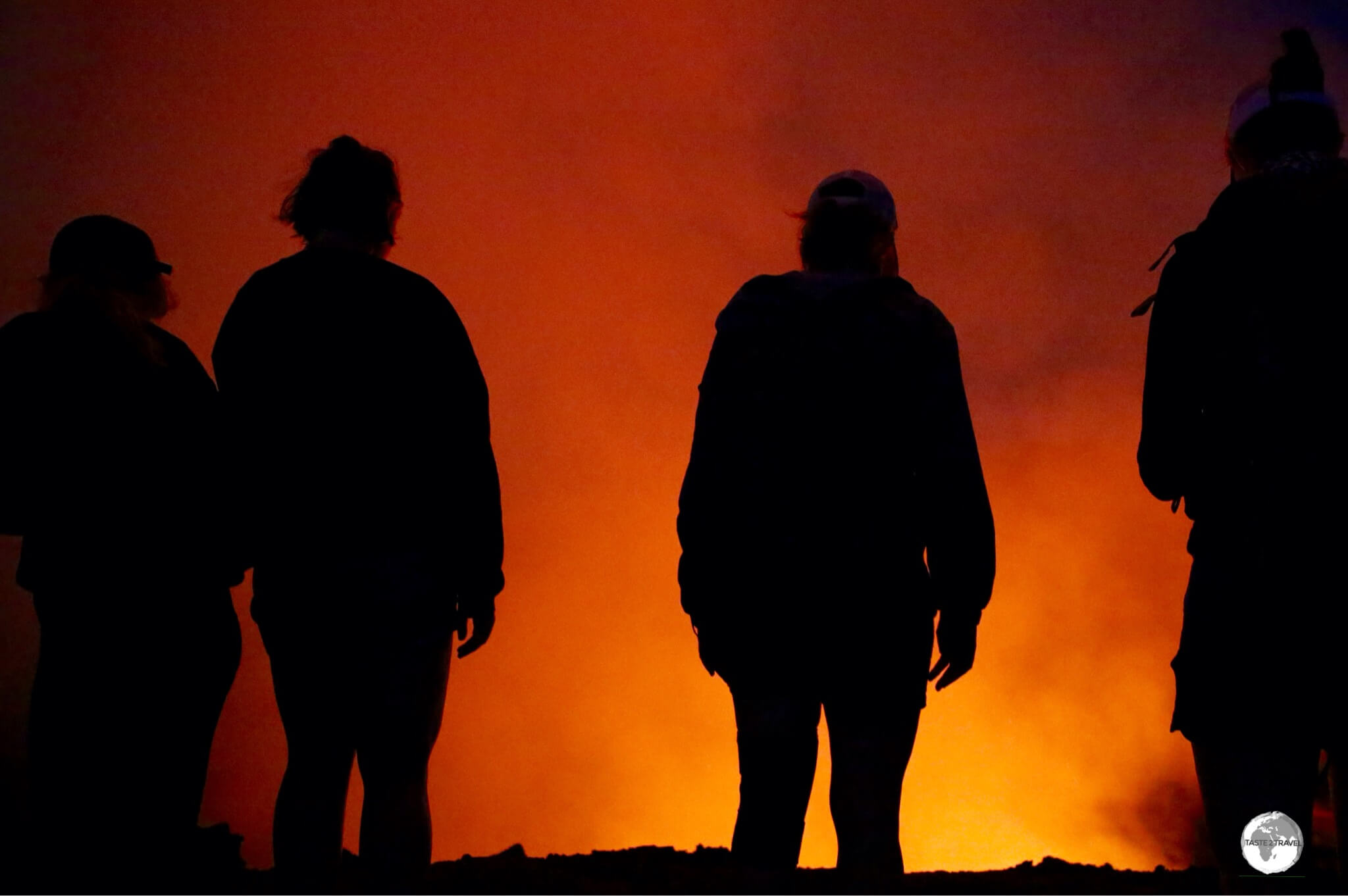
Fellow visitors, illuminated by the fiery glow from Mount Yasur volcano.
Once the sun disappears, the trail (and the edge of the crater) also disappears into the darkness of the night. Apart from the glow from the volcano, it’s very dark and you cannot afford to put one foot wrong (lest you end up falling into the crater).
I was happy to have a ‘torch’ app on my phone which was useful for lighting the trail on the return journey to the car park.
Blue Cave

The Blue Cave on Tanna.
Source: https://vanuatuindependent.com
And now for something completely different…
The shoreline along the northwest coast of Tanna is composed of limestone cliffs and hidden away inside one of these cliffs, at the very north-western point of the island, is the magnificent ‘Blue Cave‘.

Myself, making a graceful entry into the Blue Cave on Tanna island.
The only way to access this part of the island is via boat and, from the ocean side, the presence of a cave is not immediately apparent. It’s only when you dive into the deep, clear ocean water (great snorkeling) and swim with a snorkel and mask to the limestone cliffs that a small slot becomes visible just below the waterline.
This is the obscure entrance to a vast, hidden cave, which is only accessible by diving under the water and passing through the narrow entrance into the cave.

Surreal lighting inside the Blue Cave.
Once inside, you’ll find yourself in a large expansive dome-shaped cave which is lit by rays of sunlight, which beam in through a small collapsed opening in the dome.
It’s this opening which has allowed the cave to form over millennia through water erosion. The seawater in the cave is a brilliant blue (hence the name) thanks to the sunlight beaming in from the ocean side. Boat trips can be organised by any of the hotels and guest houses along the west coast.
Tanna Coffee

Tanna Coffee Company.
“My only vice in life is my morning coffee.” Quote from Darren McLean.
As a self-confessed caffeine addict, I could not leave Tanna, without first paying a visit to the headquarters of the Tanna Coffee Company.

Green Arabica beans drying in the sun at the Tanna Coffee company, before being transported to Port Vila for roasting.
Tanna coffee is famous for its full-bodied Arabica bean, with the company sourcing its beans from more than 600 small-scale family farmers scattered all over the island.
The farmers are responsible for delivering green beans to the company headquarters on Tanna, which then ships the beans to the Tanna Coffee Roasting factory near Port Vila where they are roasted and packaged. You can purchase Tanna coffee via their online shop.

Traditional village housing on Tanna island.
Espiritu Santo
A one hour flight north of Éfaté lies the largest island in the archipelago – Espiritu Santo. ‘Santo’ is home to lush rainforests, aging coconut plantations, the world’s largest wreck dive – the SS Coolidge, the bizarre American WWII dumping ground – Million Dollar Point, crystal clear blue-water, swimming holes and powdery-white-sand beaches. Several nearby islands offer superb beaches, diving and snorkeling.
The provincial centre of Luganville (pop: 16,300) is located on the southeast coast and is the 2nd largest town in Vanuatu. It’s also home to the only other international airport in the country with regular flights to Brisbane (Australia) and Nouméa (New Caledonia). Most of the island is not connected to any road network, however a single (paved) road runs for 50 km along the east coast from Luganville to the northern beach settlement of Port Orly.
Luganville
Not the most charming town in the world – the drab downtown area of Luganville is dominated by cheap Chinese stores selling cheap Chinese imports to suit the needs of the local market. In between the Chinese shops are a few glitzy new banks, the old and dated Hotel Santo, the shiny and new The Espiritu Hotel (which has a popular restaurant serving some of the best meals in town) and the wonderful Attar Bakery and Café, where you’ll find the best coffee in town (although sadly – not Tanna coffee).
WWII

WWII, US military-built, Quonset huts are still in use today in Luganville.
During WWII, Santo was the second largest US base in the Pacific (after Hawaii), with more than 40,000 troops stationed permanently on the island, most of them in Luganville.
The current street plan of Luganville was created by the Americans who laid out the streets out using a typical grid pattern which you’ll find in most US towns and cities.
The streets were lined with military-built Quonset huts, some of which are still in existence and have been converted into industrial spaces by local businesses.
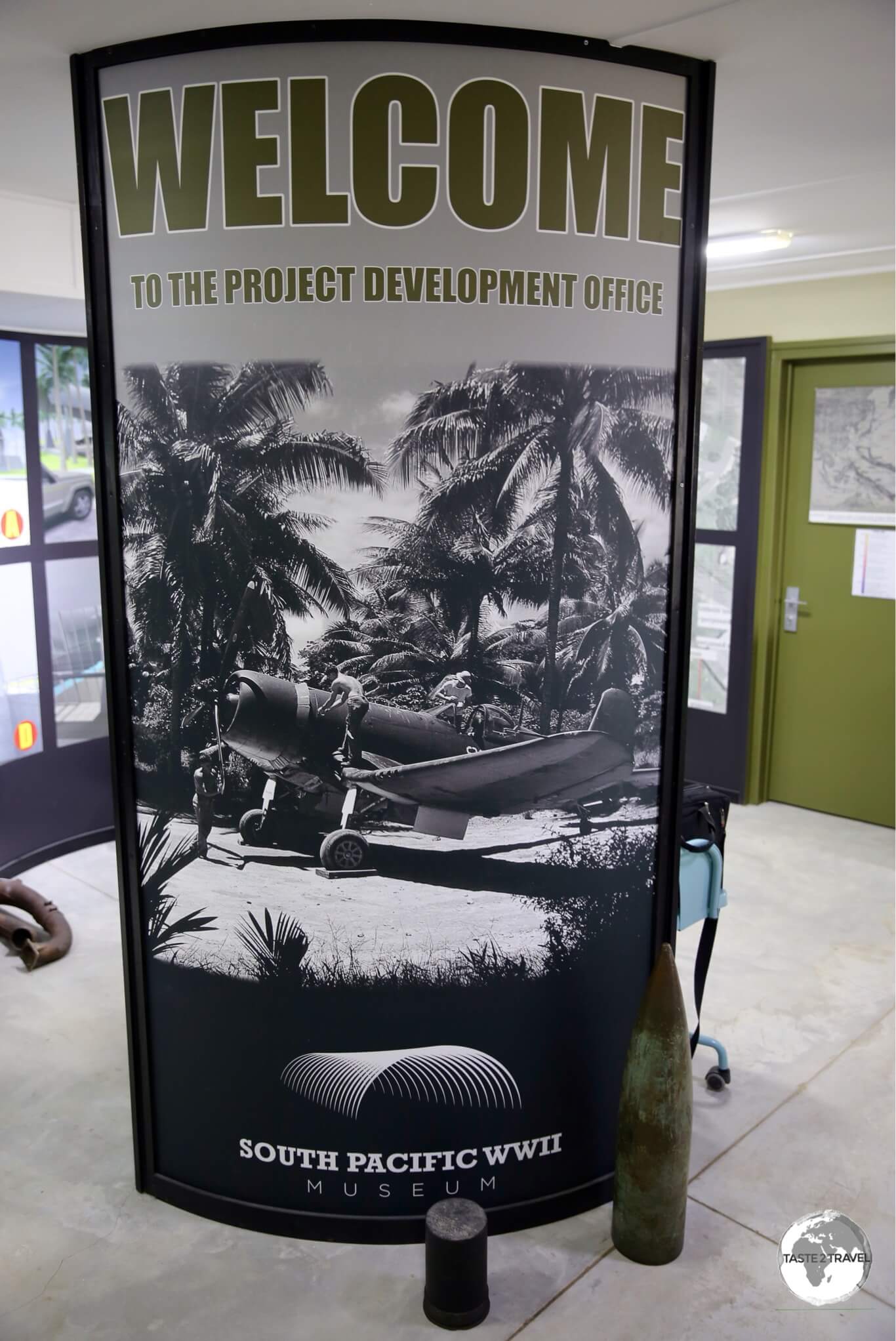
Displays at the development office of the South Pacific WWII Museum in Luganville.
A new addition to the town will be the South Pacific WWII Museum, which is currently in the development phase. A temporary development office has been established to showcase some of the relics which will grace the display cases of the completed museum (scheduled to be completed by 2022) and to allow organisers to coordinate fundraising efforts.
Gene Roddenberry in Luganville
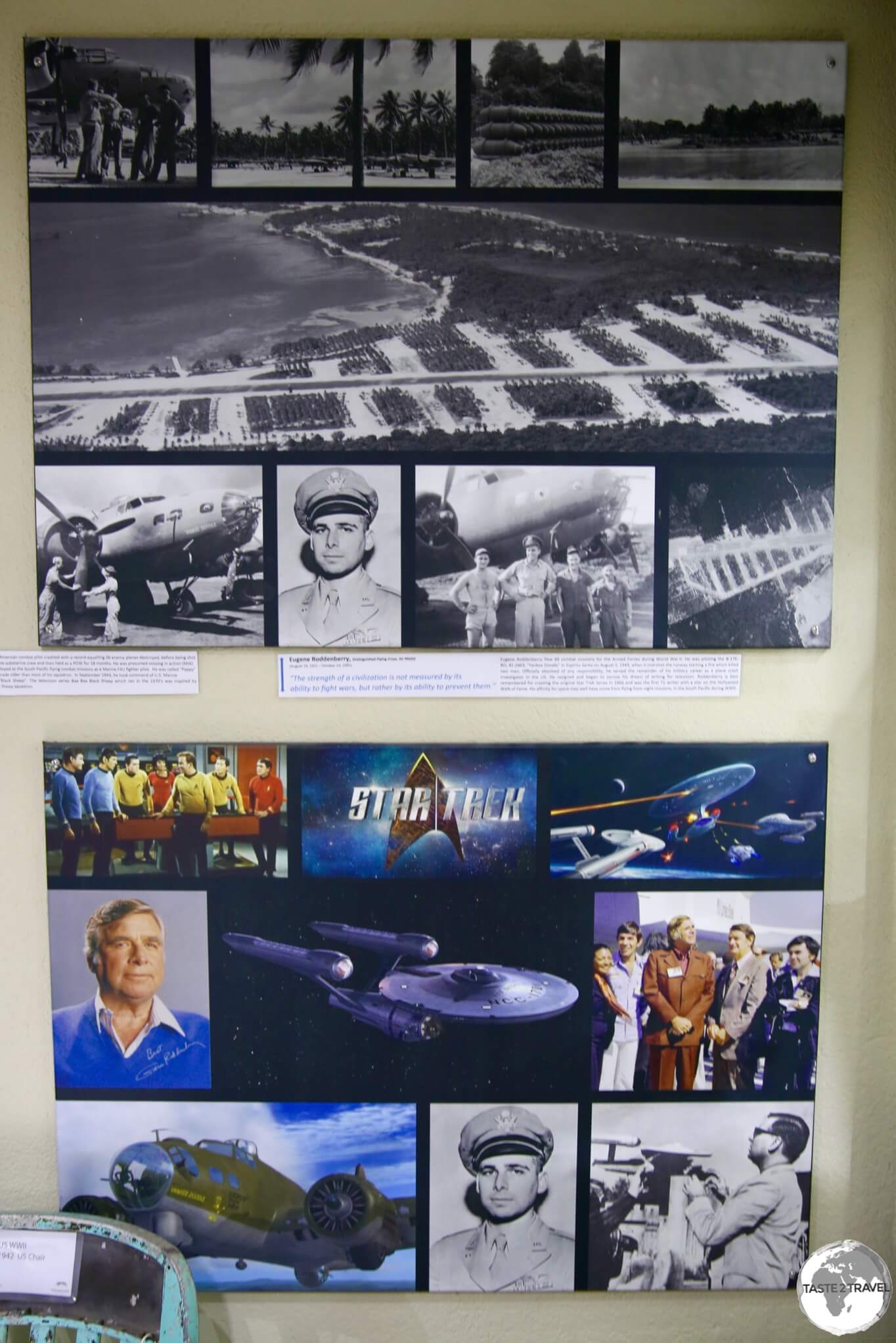
The ‘Gene Roddenberry’ display at the South Pacific WWII museum in Luganville.
During the war, there were several aviation accidents on Santo, one of which happened on the 2nd of August 1943, when a B-17 bomber, “Yankee Doodle”, overshot the runway by 150 m (500 feet), impacted trees, crushing the nose, and starting a fire – killing two men.
The young Army pilot of that plane, Gene Rodenberry, survived and would later find worldwide fame as the creator of Star Trek. A display at the museum tells the story of Mr Roddenberry’s time on Santo during the war.
SS Coolidge
The SS Coolidge was an American luxury liner converted for military use in WWII. Due to poor communications, it was sunk by friendly mines while enter Luganville harbour and is today the world’s largest wreck dive.

The SS Coolidge shortly before it sank.
Source: discovervanuatu.com
Next to the Attar Bakery and Cafe is the home and dive shop of Allan Power who is ‘Mr SS Coolidge’. If you plan to dive the SS Coolidge, you should do it with someone who has dived the wreck 15,000 times. Yes – 15,000 times!
Originally from Australia, where he use to spend his time photographing fish on the Great Barrier Reef, Allan has called Luganville home for the past 49 years and has made the Coolidge his life’s work. No one knows the SS Coolidge better than Allan who, now in his 80’s, still drives divers in his minibus each morning out to the wreck site but leaves the diving to his very capable team of dive-masters.

Diving the SS Coolidge.
Source: discovervanuatu.com
Million Dollar Point
Today, reminders of the war can be found scattered around the island, nowhere more so than at Million Dollar Point, which is located on Segond Channel less than a kilometre to the east of the SS Coolidge.

Rusty WWII relics litter the beach at Million Dollar Point.
At the end of the war, the Americans had insufficient space on their ships returning to the US to fit all the masses of equipment that had accumulated on Santo. The priority for the US government was the safe return of its troops so it was decided to leave the equipment behind.

Million Dollar Point is an environmental catastrophe and also a popular dive and snorkel site.
The US offered to sell all the surplus equipment to the Colonial (French/ English) Government at a very low price. However the government refused to pay, believing the Americans would simply leave the equipment and they would acquire it free of charge. The Americans however had another idea. They lined up all the surplus equipment on the shore with engines running then placed bricks on the accelerators and let the equipment rumble into the channel, a channel which has a drop-off to 35 metres. It is believed about a million dollars worth of equipment was dumped, hence the name.
Tales of the South Pacific

Tales of the South Pacific was written by James A. Michener during his time on Espiritu Santo.
One of America’s favourite storytellers, James A. Michener wrote Tales of the South Pacific while stationed in Espiritu Santo during WWII. The book was later adapted as the Broadway musical ‘South Pacific‘ by Rodgers and Hammerstein. The musical was made into a feature film in 1958 and in 2001 it was made into a Film for Television.
Around Espiritu Santo

The one highway on Espiritu Santo runs along the east coast.
Touring Santo is easy really – there’s just one paved road along the east coast which connects Luganville with the settlement of Port Orly – a 50 km leisurely drive which passes a number of sights along the way.

A perfect swimming spot – Riri blue hole, one of several such natural pools on Santo.
Normally I would hire a rental car, but with the two rental companies in Luganville charging at least 10,000VT for a car, I decided to tour the island with the wonderfully charismatic and knowledgeable Esline Turner from Santo Seaside Villas. It was far cheaper and much more informative.
Together with two other guests from Santo Seaside Villas, I spent the day with Esline exploring such sights as:
- A former US military vault which is hidden away in the back streets of Luganville.

A former US military vault which once stored the salaries of US troops.
- Million Dollar Point, the ultimate WWII dumping ground and environmental disaster.

Million Dollar Point was used as a dumping ground for US equipment at the end of WWII.
- The Wreck of a B-17 bomber which is now hidden in overgrown jungle near to Million Dollar Point

Located in the middle of the jungle on Espiritu Santo, this wreck of a B-17 bomber can only be found with a knowledgeable guide.
- Riri Blue Hole (500VT) – one of a few blue holes on the island, Riri is the perfect place for a refreshing dip in a freshwater swimming hole.

Santo is home to several fresh-water blue holes, including beautiful Riri.
- Champagne Beach (2,000VT per vehicle) – a secluded, undeveloped, stunningly beautiful white-sand beach which is occasionally visited by cruise ships.

A nice beach to have to yourself, Champagne Beach is the finest beach on Espiritu Santo.
- Port Olry – a small settlement at the end of the road which offers two restaurants and limited accommodation overlooking a white-sand beach which is lapped by milky-blue surf.

The white-sand beach at Port Olry.
Malo Island

One of the many friendly village children on Malo Island.
Located 3 kilometres off the southern shore of Santo, sleepy Malo Island is home to a few thousand souls, coconut and cocoa plantations, incredible nature, lots of birds, beautiful wild orchids, pristine beaches and wonderful snorkeling. I visited Malo on a day trip with Esline Turner from Santo Seaside Villas aboard her glass-bottom boat.

Beautiful Malo Island.
On-route to Malo, we stopped to snorkel on a remote, pristine reef where the abundance of marine life was dazzling.
Once we reached Malo, we anchored at a remote, sandy beach which was shaded by giant, ancient Tamanu trees, which host many different types of plants on their huge branches, including native orchids. The trees extend outwards over the water, providing the perfect canopy and protection from the blazing sun.

Giant Tamanu trees provide ample shade on the beach at Malo Island and host several native species of wild orchids.
The local villagers had raked the sandy beach and had prepared a BBQ which Esline used to cook amazingly tender Santo steaks and grilled fish.
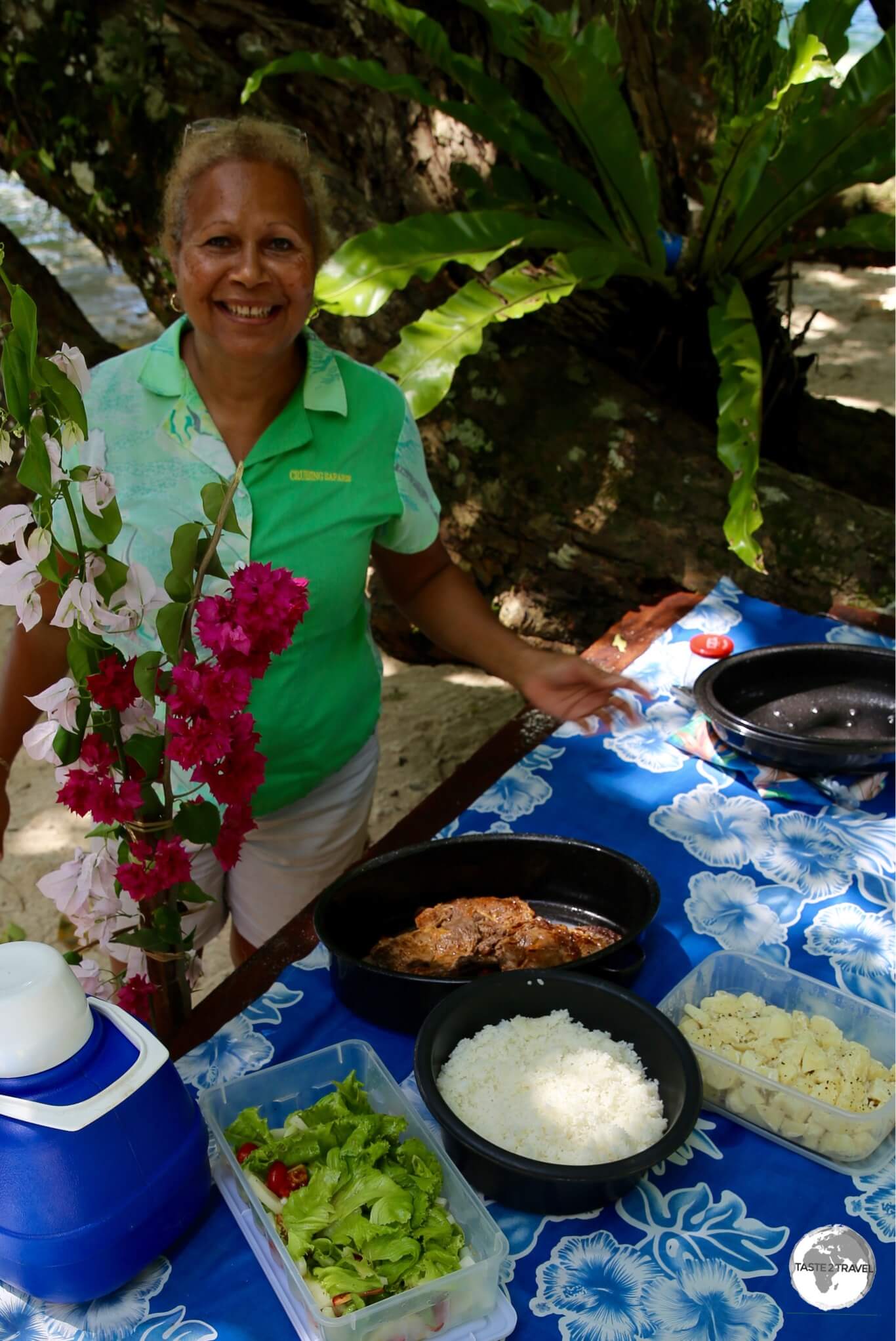
Our amazing guide, Esline Turner, preparing a delicious lunch on Malo Island.
After a delicious lunch we had time to relax and snorkel before Esline led us on a short island walk – Esline is a native of Malo and is proud to be able to show visitors her beautiful island. After the walk we boarded the boat and motored back to Luganville. A great day out!
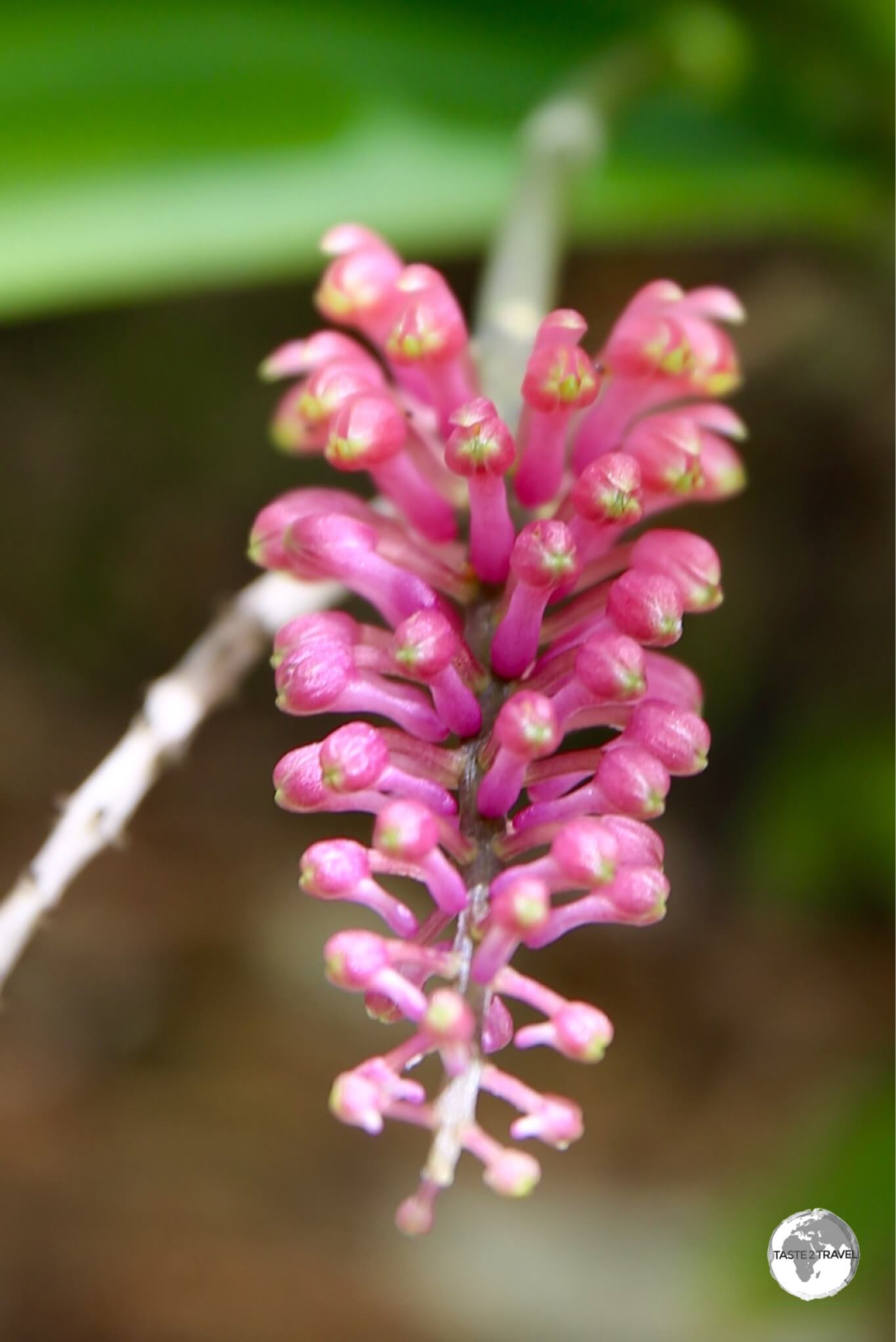
A wild orchid on Malo Island.
Accommodation
Éfaté Island
Iririki Resort and Spa
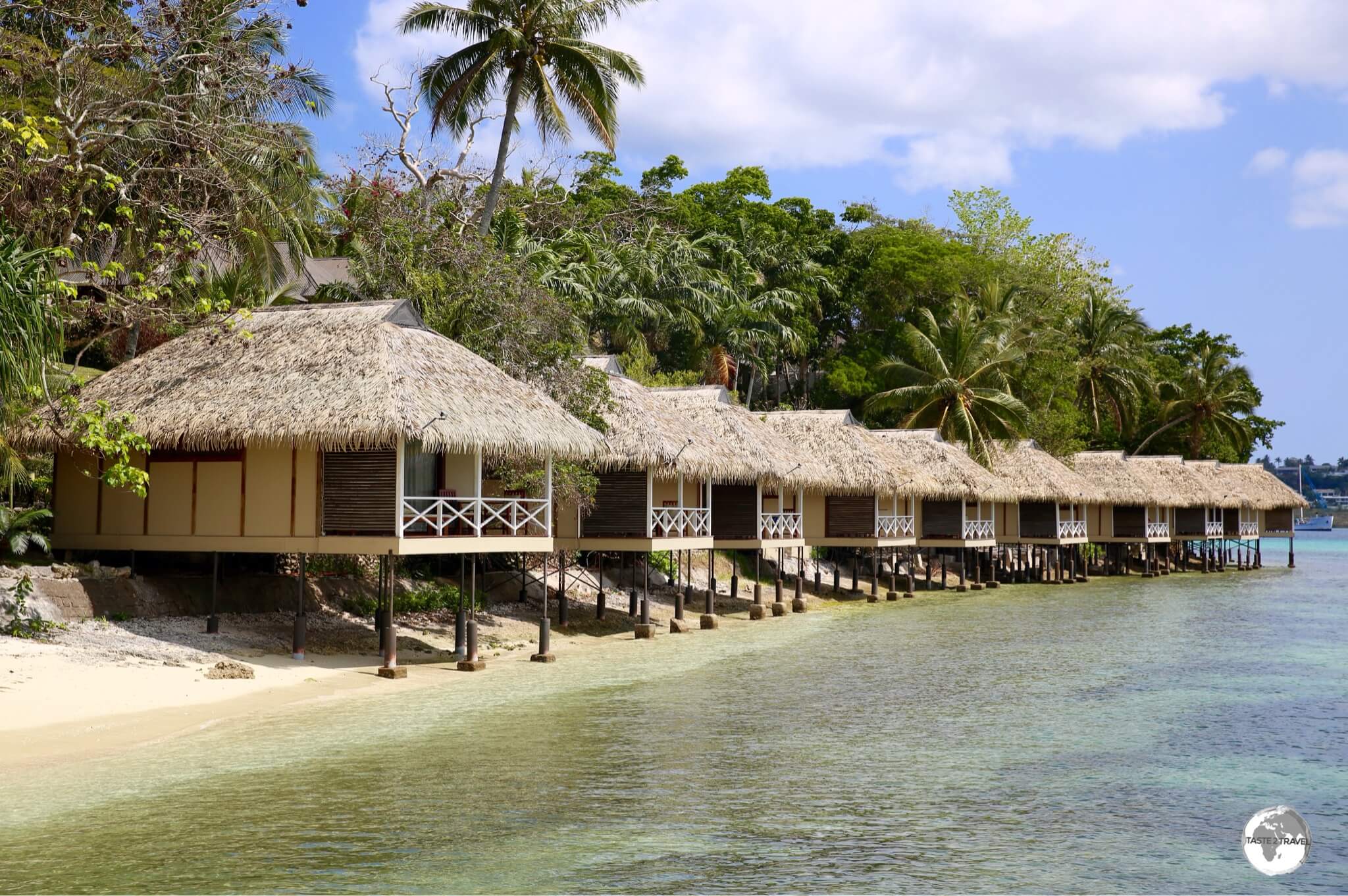
Waterfront bungalows at the private island, Iririki Resort and Spa, in Port Vila.
Not many cities can boast having a 5-star private-island resort in the middle of their harbour. Located across a narrow channel from downtown Port Vila, Iririki Resort & Spa offers eight different types of rooms, swimming pools, restaurants, a casino, spa, snorkeling and everything else you would expect from a 5-star resort.
Access to the resort is via a free shuttle boat which departs from behind the Central market.
Seachange Lodge

The living room in ‘The Cottage’ at Seachange Lodge.
While in Port Vila, I stayed at the wonderful Seachange Lodge which is owned by the amazing Ian Kerr, a New Zealand expat who has settled in Vanuatu after many years of running successful businesses in New Zealand and Australia.

The kitchen in ‘The Cottage’ at Seachange Lodge.
Ian is a keen promoter of Vanuatu and was instrumental in the planning process of my trip, which was done on my first day using the hand-painted, wall-sized map of Vanuatu which decorates the reception area of his lodge.

One of the two spacious bedrooms in ‘The Cottage’ at Seachange Lodge.
Ian introduced me to everyone I needed to know and ensured I didn’t leave any stone unturned. I thank Ian for making my stay in Vanuatu a memorable one and recommend his wonderful guesthouse as THE place to stay while in Port Vila. Ian offers a range of accommodation at his lodge from cheaper backpacker rooms to deluxe, lagoon-side bungalows.
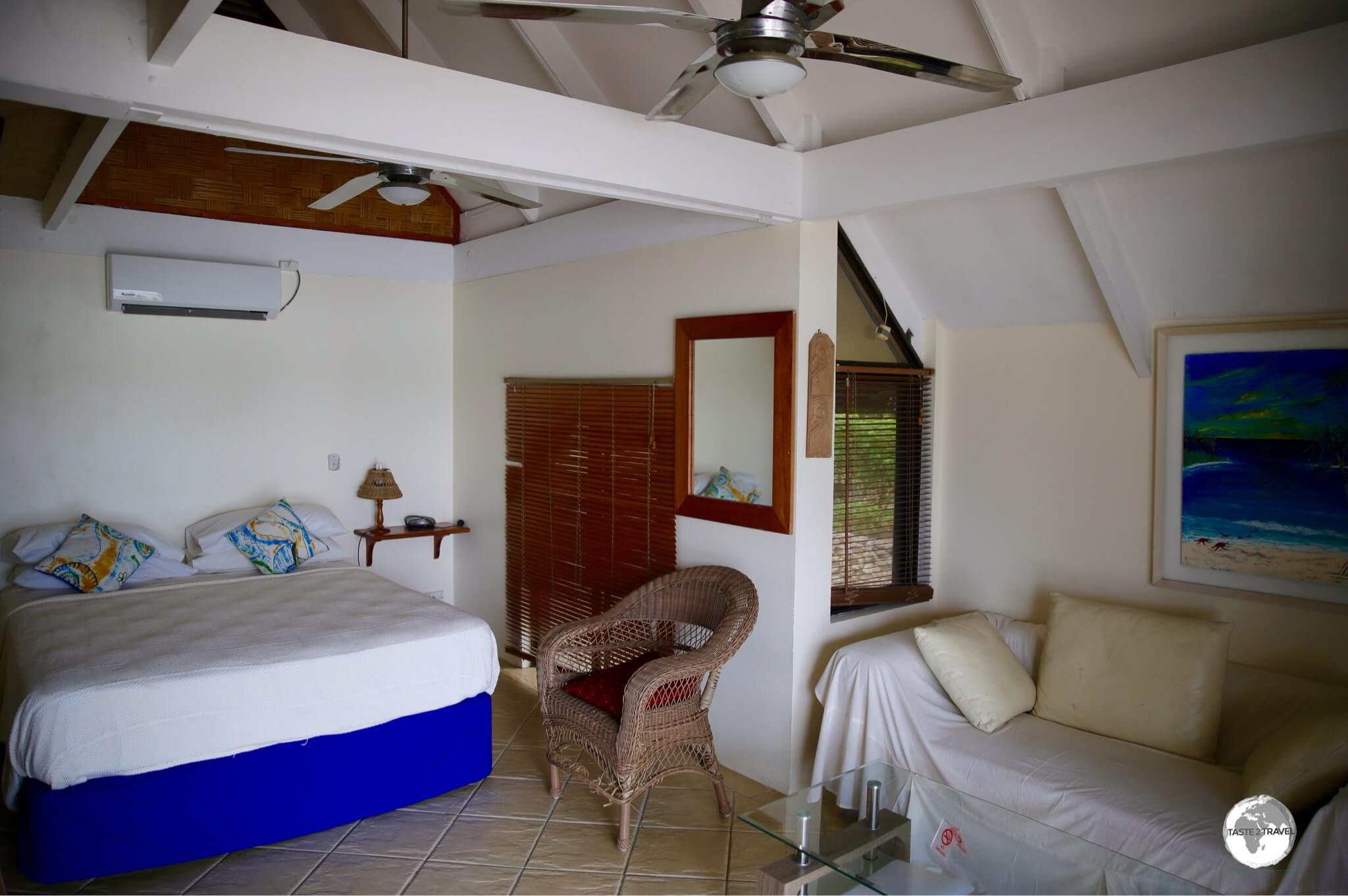
The bedroom in the ‘Lagoon bungalow’ at Seachange Lodge.
Seachange Lodge is a home away from home and I can’t wait to return!

The bathroom, with spa bath, in the ‘Lagoon bungalow’ at Seachange Lodge.
Tanna Island
Friendly Beach Resort

The comfortable interior of my bungalow at Friendly Beach Resort.
While on Tanna, I stayed at the Friendly Beach Resort which is located on an isolated, black-sand beach on the very remote east coast. Access to the resort is via a rough 4WD track through lush tropical rainforest.

My bungalow at the very remote Friendly Beach Resort.
The resort consists of four spacious beach-side bungalows, which have been constructed from wood and bamboo using traditional techniques. All bungalows were painstakingly rebuilt following the destruction wrought by cyclone Pam in 2015.

One of the friendly staff members at Friendly Beach Resort weaving a traditional basket.
The staff at ‘Friendly’ are very friendly and helpful and will ensure you get the most from your visit to Tanna. All staff are recruited from the nearby village of Louna Sunan which is a short walk up the 4WD track.

Attending a Sunday church service in the village of Louna Sunan on Tanna island.
The villagers are incredibly friendly and welcoming and on one Sunday, I attended a village church service which was a very nice experience.

A young girl is distracted during a church service in the village of Louna Sunan.
If you wish to drop off the grid and escape from the world at large then this is your place. There is no Wi-Fi and leaving the resort requires you to hire the services of the resort taxi (it is a long way from anywhere!). Lighting is provided for 6 hours each evening via a generator.

My presence was a novelty for the children of Louna Sunan, who were clearly bored with the church service.
Meals are served three times a day and, upon request, can include such delicacies as local lobster (divine!).
Espiritu Santo
Santo Seaside Villas

My spacious, tastefully decorated villa at Santo Seaside Villas.
On Santo, I based myself in the main town of Luganville, at the very comfortable Santo Seaside Villas. Overlooking the Segond Channel, a few kilometres from town, the property features two spacious, well-appointed, villas and one smaller studio apartment.

Esline Turner provides a wonderful continental breakfast each morning at Santo Seaside Villas.
The property is owned by the wonderful Esline Turner and her husband John. This dynamic duo also offer snorkeling trips to Malo Island in their glass-bottom boat and full-day island tours of Santo.

The shipwreck at Santo Seaside Villas features a nice snorkeling reef.
Directly in front of the property is a beautiful wreck of an old trading boat which became marooned years ago during a cyclone. The wreck is surrounded by a small reef which makes for ideal snorkeling.

Bungalows at the Beachfront resort in Luganville.
I also stayed at the Beachfront Resort which offers beautiful, air-conditioned, bungalows which are surrounded by lush tropical gardens, overlooking the bay. The restaurant serves very fine meals and the swimming pool is one of the best in town.
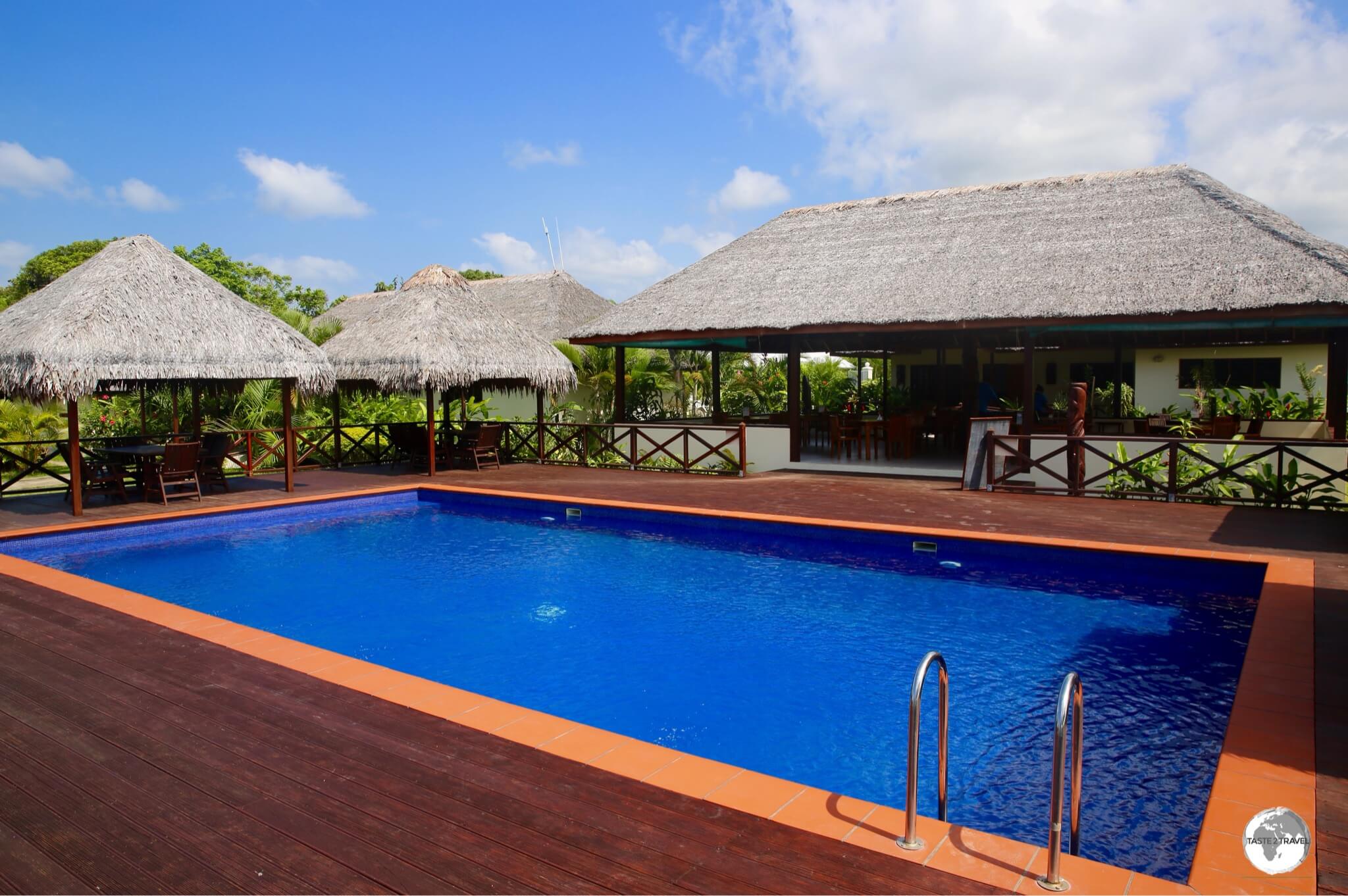
The restaurant and pool area at the Beachfront resort in Luganville.
The best accommodation option downtown is the modern and new The Espiritu Hotel.
Eating Out
Éfaté Island
Port Vila is a foodies’ paradise, offering a good selection of restaurants from fine dining to casual takeaway, all in a small downtown area.
Fine Dining
If you’re celebrating a special occasion or wish to experience fine dining, the Blue Marlin Club will not disappoint. Located on a hill overlooking the harbour, everything about this gourmet heaven is elevated. The talented UK chief (Matt) is a master of his craft and prepared for me the most divine Vanuatu steak. This is the pinnacle of dining in Port Vila.
Not to be out-done is the legendary L’Houstalet which is the oldest restaurant in town. Founded in 1973 by French Chief, Clement Martinez, who still works in the restaurant each evening, the surroundings and décor are simple and unpretentious, but the food is anything but.
From Vanuatu steak with Roquefort sauce or Lobster Thermidor, the meals served by Clement are truly memorable. Clement has stated that his goal is to remain in the restaurant to celebrate its 50th anniversary in 2023. A speciality of the house is the roasted flying fox!
Cafés

Le Cafe du Village in Port Vila serves wonderful Tanna coffee.
I started most days in Port Vila with a leisurely breakfast at Le Cafe du Village which is located on the waterfront. The service, coffee and food are all divine with the breakfast menu offering everything from Eggs Benedict to muesli to pancakes. The cafe is open for breakfast, lunch and dinner and includes a cosy bar area.

A fine Vanuatu raspberry tart made by the French pastry chief at ‘Au Peche Mignon’ in Port Vila.
Another cafe which I frequented is the wonderfully French – Au Peche Mignon. From the fine French pastries to the French-speaking staff, it all feels like a slice of Nouméa in Port Vila. Despite being so French, they make a mean meat pie!

Coffee at ‘Au Peche Mignon’ in Port Vila.
Jill’s Cafe is always popular and, thanks to its American owner, offers a US-inspired menu. If you’re in the mood for a fully loaded sandwich or a milkshake this is your place. Jill’s is the only cafe in town which serves Tanna coffee.
On the waterfront near to Jill’s, the Nambawan Cafe & Bar offers meals, coffee, a full bar and a free outdoor cinema. In the same complex, Pad Thai serves authentic Thai food which is prepared by the friendly Thai chief. His ‘chicken with ginger’ is straight from the streets of Bangkok.

Freshly roasted Tanna coffee on sale at the Tanna Coffee Roasting company in Port Vila.
For the absolute best coffee anywhere in Vanuatu, you’ll need to head outside of Port Vila towards the village of Mele where you’ll find the Tanna Coffee Roasting Company. Located on the main road, Tanna coffee provide visitors with a free guided tour of their small factory after which you can order a coffee at their cafe. Food and cakes are also available.
Other Restaurants
A short walk along the waterfront from Le Cafe du Village is the popular Waterfront Bar & Grill Restaurant where the beers are cold and the steaks and fish are always excellent.
A special dining experience is offered a short drive from Port Vila at the lagoon-side Vila Chaumières where the chief, Samson, has been cooking up a storm for more than 20 years. The eclectic menu includes culinary influences from around the world, including French, Cajun, Indian and local. I sampled the Coconut crab which was heavenly.
Cheap Eats

Cheap (but delicious) street food can be found at the Central market in Port Vila.
There are plenty of cheap eats in Port Vila, with the cheapest being the food stands inside the central market, where you can buy parcels of freshly cooked vegetables topped with a piece of grilled meat for just 200VT.
Tanna Island
Most guest houses on Tanna provide full board for their guests due to their remote locations. I ate all meals at my guest house – Friendly Beach Resort – which served filling, tasty meals which showcased local seafood and produce.
Espiritu Santo

Roadside food stand on Espiritu Santo.
Dining options in downtown Luganville include the wonderful restaurant at the shiny and new The Espiritu Hotel which offers a creative international menu. I enjoyed the local sweet potato Gnocchi served with pesto sauce.
Across the road from The Espiritu Hotel is the best cafe in town, the Attar Bakery and Café which is open until late most evenings. The selection of food, freshly baked cakes and delicious coffee ensure this place is always busy.
Outside of town, the restaurant at the Beachfront Resort offers fine meals which feature delicious local produce including the famed Santo Beef.
Visa Requirements

Vanuatu Passport Stamp.
Currently 120 different nationalities can enter Vanuatu without a visa, either for a period of 30 days or 90 days, depending on your nationality. For more information, you should check the current Visa Policy of Vanuatu.
Immigration
The Vanuatu Immigration service require all visitors to show a return ticket upon arrival – and they do check!
Getting There

Arriving on Tanna Island with Air Vanuatu.
Air
Vanuatu has two international airports with the main gateway being Bauerfield International Airport in Port Vila while Santo-Pekoa International Airport on Espiritu Santo has international flights to/from Brisbane and Nouméa.
Éfaté Island
Bauerfield International Airport (IATA: VLI) serves as the hub for Air Vanuatu and offers the following connections:
- Air Niugini – flies to/from Honiara, Port Moresby
- Air Vanuatu – flies to/from Auckland, Brisbane, Dillon’s Bay, Emae, Honiara, Ipota, Lamap, Lamen Bay, Lonorore, Luganville, Nadi, Norsup, Nouméa, Paama, South West Bay, Suva, Sydney, Tanna, Tongoa, Ulei, Valesdir
- Aircalin – flies to/from Nouméa
- Fiji Airways – flies to/from Nadi, Suva
- Solomon Airlines – flies to/from Honiara
- Virgin Australia – flies to/from Brisbane
Airport Transport
From Bauerfield International Airport, taxis (2,500 VT) and public buses (1,000 VT) are available to downtown Port Vila.
Espiritu Santo
Santo-Pekoa International Airport (IATA: SON) offers the following connections:
- Air Vanuatu – flies to/from Brisbane, Nouméa, Craig Cove, Gaua, Longana, Port Vila, Sola, Walaha
Airport Transport
From Santo-Pekoa International Airport, taxis (1,500 VT) and public buses (150 VT) are available to downtown Luganville.
Sea

A P&O cruise ship in Port Vila.
Éfaté Island
Cruise ships visit Port Vila every other day, docking adjacent to the (less-than-pretty) container terminal a few kilometres south of town. Most ships operate out of Australia, delivering hoards of Australian day-trippers to the capital. You can view the busy cruise ship schedule here.
Espiritu Santo
Luganville
Five cruise ship arrivals are currently scheduled for 2018.
Champagne Beach
Eleven cruise ship arrivals are currently scheduled for 2018. There are no facilities on this remote (but incredibly beautiful) white-sand beach but locals setup pop-up shops to cater for the day-tripping hoards.

A P&O cruise ship departing Port Vila.
Getting Around
Éfaté Island
Public Transport
Public buses in Vanuatu sport a red ‘B‘ on their license plate and it seems every second vehicle on the streets of Port Vila is a public bus – all of which are either Japanese or Korean mini-vans.
Supply outstrips demand with drivers cruising around looking for passengers (and causing congestion!). Buses operate from point-to-point, charging 150VT for drops in the downtown area and more for longer rides – you need to negotiate the fare in advance.
Taxi
Like buses, taxis on Vanuatu display a red ‘T‘ on their license plate. Taxis are un-metered but cheap and plentiful.
Rental Car

The Vanuatu license plate of my rental car on Efate.
Just as buses and taxis are designated with a red ‘B‘ or ‘T‘, hire cars are designated with a green ‘H‘. The best way to maximise your time on Éfaté is by renting a car. Armed with a good (free) map from the tourist office, you’ll be able to discover most of the attractions on this fascinating island by yourself.
There are plenty of rental car agents in downtown Port Vila, most of whom are grouped together along Rue D’Artois.
- Hertz – located downtown on Rue D’Artois.
- Avis– office at the airport and downtown on Rue D’Artois.
- Budget – office downtown on Rue D’Artois
- Europcar – office at the airport and on the Lini highway in downtown Port Vila.
- World Car Rentals – office in Port Vila on the Kumul highway, they’ll deliver and pick-up from your hotel.
- Go 2 Rent – office downtown on the Kumul highway.
Tanna Island

Most roads on Tanna are un-signposted, rough, 4WD tracks. Not surprisingly, there are no rental cars on the island.
The road along the west coast of Tanna, which connects the airport to some of the resorts and Lenakel, is sealed while most other roads are unpaved, deeply rutted and adventurous.
Public Transport
There are no buses on Tanna but some pickups operate as shared taxis.
Taxi
4WD pickup trucks operate as shared taxis on the tough roads of Tanna with most shuttling between the main town of Lenakel and the various remote settlements. Most tourists engage private drivers to get from A to B, all of which can be organised by your guest house and will cost a small fortune.
Rental Car
There are no rental cars on Tanna and once you see the condition of the roads (and complete lack of signage) you’ll understand why!
Espiritu Santo
Public Transport
There are plenty of public buses shuttling along the main road in Luganville, operating from point to point, charging 150VT around town.
Taxi
There are plenty of taxis in Luganville, with fares as cheap as the buses, averaging 150VT for drops around town and 300 VT for longer drops.
Rental Car
Unlike the bargain taxis, rental cars on Santo are not cheap, starting at 10,000VT (USD$90) per day. Guest houses can normally offer cheaper guided tours of the island. I personally recommend the island tour conducted by Esline Turner of Santo Seaside Villas – cheaper than a rental car, much more informative and definitely more entertaining.
If you wish to splash some cash on an expensive rental, you can do so by contacting the following agents in Luganville:
- The Espiritu Hotel & Car Rental – this smart hotel offers 2WD SUVs from 10,000VT per day and seems to be the best option.
- Santo Car Hire – rents dual-cab pickups (14,000VT per day), Quad bikes (12,000VT per day) and UTV’s (12,000 – 18,000VT per day).
That’s the end of my Vanuatu Travel Guide.
Safe Travels!
Darren
Follow me on Instagram:
[instagram-feed feed=1]
Further Reading
Other travel reports from the Pacific region:
Vanuatu Travel Guide Vanuatu Travel Guide Vanuatu Travel Guide Vanuatu Travel Vanuatu Travel Guide Vanuatu Travel Guide Vanuatu Travel Guide Vanuatu Travel Guide Vanuatu Travel Guide Vanuatu Travel Guide Vanuatu Travel Guide Vanuatu Travel Guide Vanuatu Travel Guide Vanuatu Travel Guide Vanuatu Travel Guide Vanuatu Travel Guide Vanuatu Travel Guide Vanuatu Travel Guide Vanuatu Travel Guide Vanuatu Travel Guide Vanuatu Travel Guide Vanuatu Travel Guide Vanuatu Travel Guide Vanuatu Travel Guide Vanuatu Travel Guide Vanuatu Travel Guide
Author: Darren McLean
Darren McLean is an Australian, full-time, digital nomad who has spent 37 years on a slow meander around the globe, visiting all seven continents, 192/ 193 UN countries and 245/ 251 UN+ countries and territories.
He founded taste2travel to pique one’s curiosity and inspire wanderlust.




